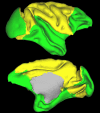Key role of coupling, delay, and noise in resting brain fluctuations
- PMID: 19497858
- PMCID: PMC2690605
- DOI: 10.1073/pnas.0901831106
Key role of coupling, delay, and noise in resting brain fluctuations
Erratum in
- Proc Natl Acad Sci U S A. 2009 Jul 21;106(29):12207-8
Abstract
A growing body of neuroimaging research has documented that, in the absence of an explicit task, the brain shows temporally coherent activity. This so-called "resting state" activity or, more explicitly, the default-mode network, has been associated with daydreaming, free association, stream of consciousness, or inner rehearsal in humans, but similar patterns have also been found under anesthesia and in monkeys. Spatiotemporal activity patterns in the default-mode network are both complex and consistent, which raises the question whether they are the expression of an interesting cognitive architecture or the consequence of intrinsic network constraints. In numerical simulation, we studied the dynamics of a simplified cortical network using 38 noise-driven (Wilson-Cowan) oscillators, which in isolation remain just below their oscillatory threshold. Time delay coupling based on lengths and strengths of primate corticocortical pathways leads to the emergence of 2 sets of 40-Hz oscillators. The sets showed synchronization that was anticorrelated at <0.1 Hz across the sets in line with a wide range of recent experimental observations. Systematic variation of conduction velocity, coupling strength, and noise level indicate a high sensitivity of emerging synchrony as well as simulated blood flow blood oxygen level-dependent (BOLD) on the underlying parameter values. Optimal sensitivity was observed around conduction velocities of 1-2 m/s, with very weak coupling between oscillators. An additional finding was that the optimal noise level had a characteristic scale, indicating the presence of stochastic resonance, which allows the network dynamics to respond with high sensitivity to changes in diffuse feedback activity.
Conflict of interest statement
The authors declare no conflict of interest.
Figures





References
-
- Arieli A, Sterkin A, Grinvald A, Aertsen A. Dynamics of ongoing activity: Explanation of the large variability in evoked cortical responses. Science. 1996;273:1868–1871. - PubMed
-
- Biswal B, Yetkin F, Haughton V, Hyde J. Functional connectivity in the motor cortex of resting human brain using echo-planar MRI. Magn Reson Med. 1995;34:537–541. - PubMed
-
- Shulman G, et al. Common blood flow changes across visual tasks: II. Decreases in cerebral cortex. J Cognit Neurosci. 1997;9:648–663. - PubMed
-
- Gusnard D, Raichle M. Searching for a baseline: Functional imaging and the resting human brain. Nat Rev Neurosci. 2001;2:685–694. - PubMed
-
- Raichle M, Mintun M. Brain work and brain imaging. Annu Rev Neurosci. 2006;29:449–476. - PubMed
MeSH terms
LinkOut - more resources
Full Text Sources
Medical

